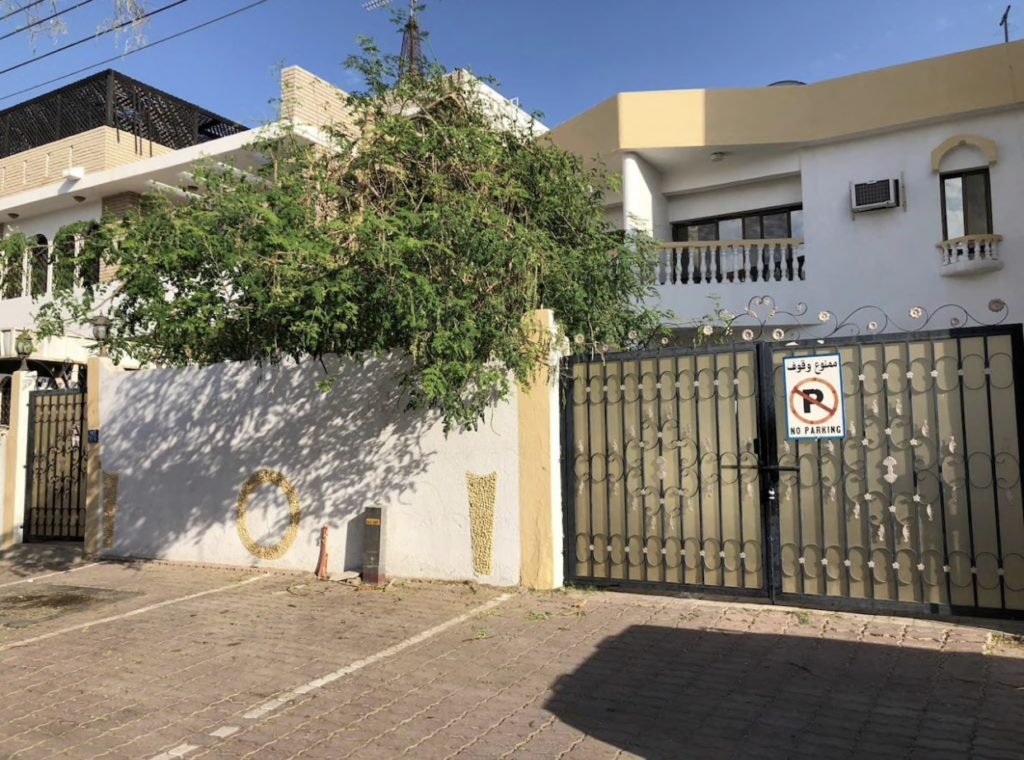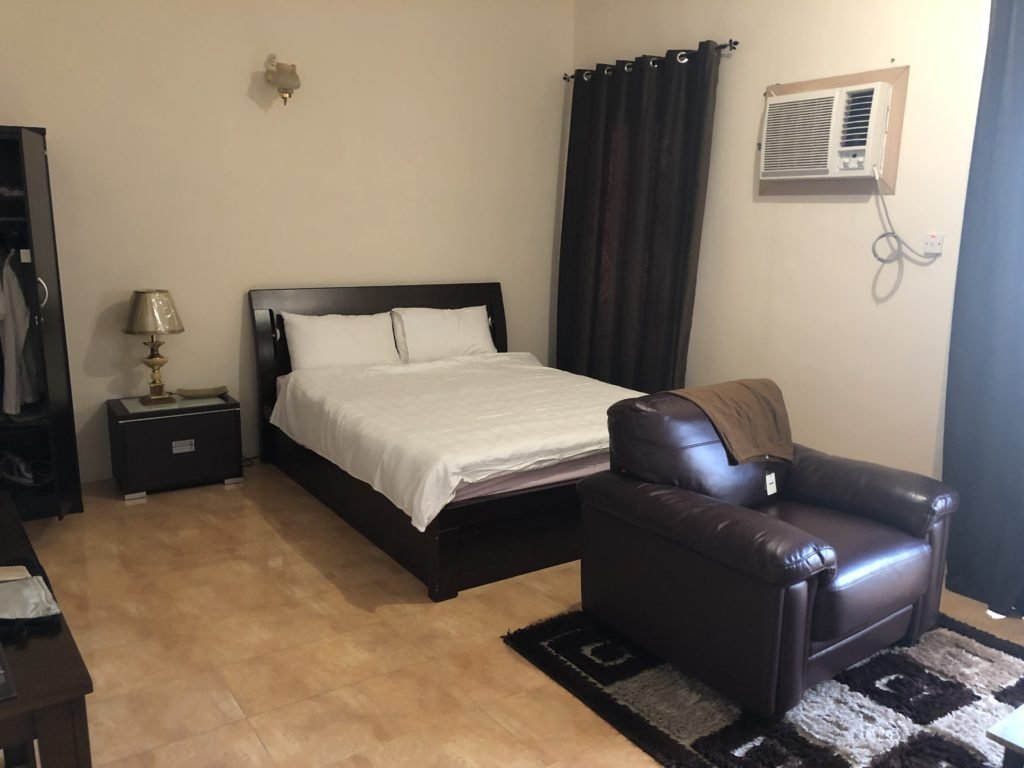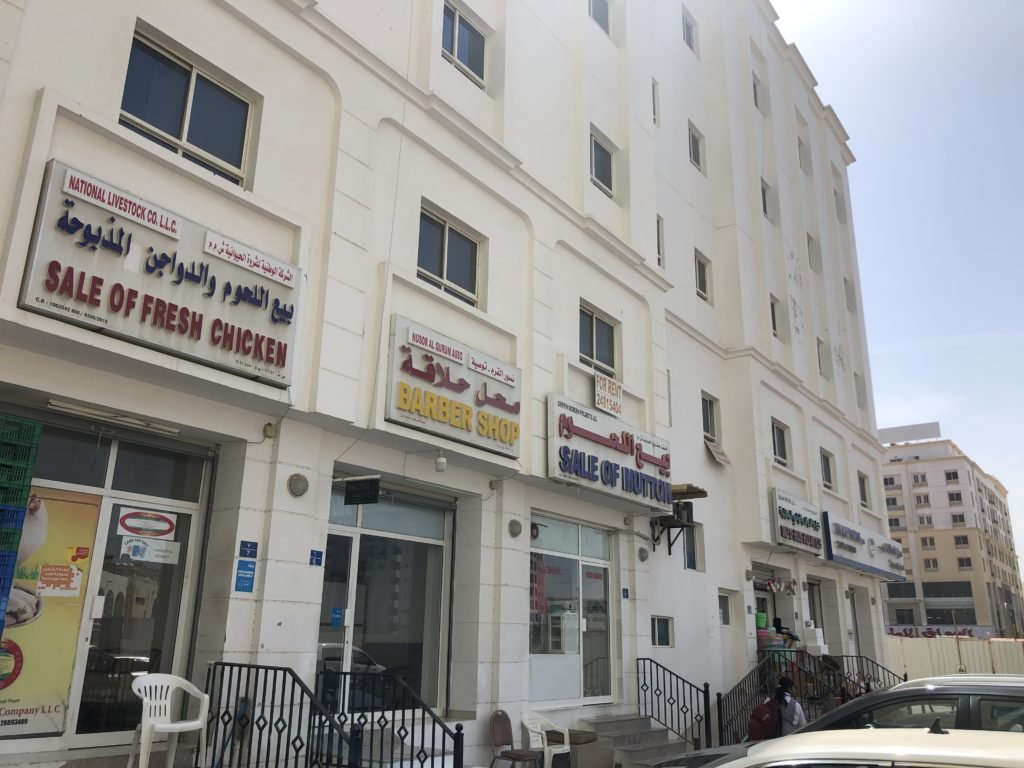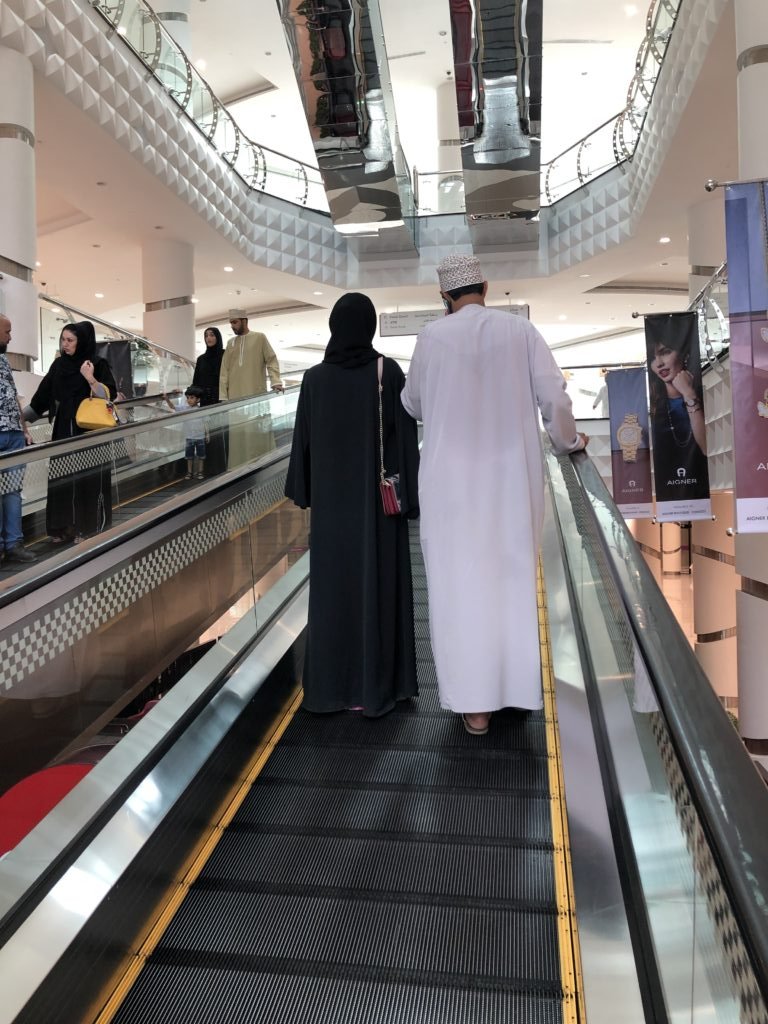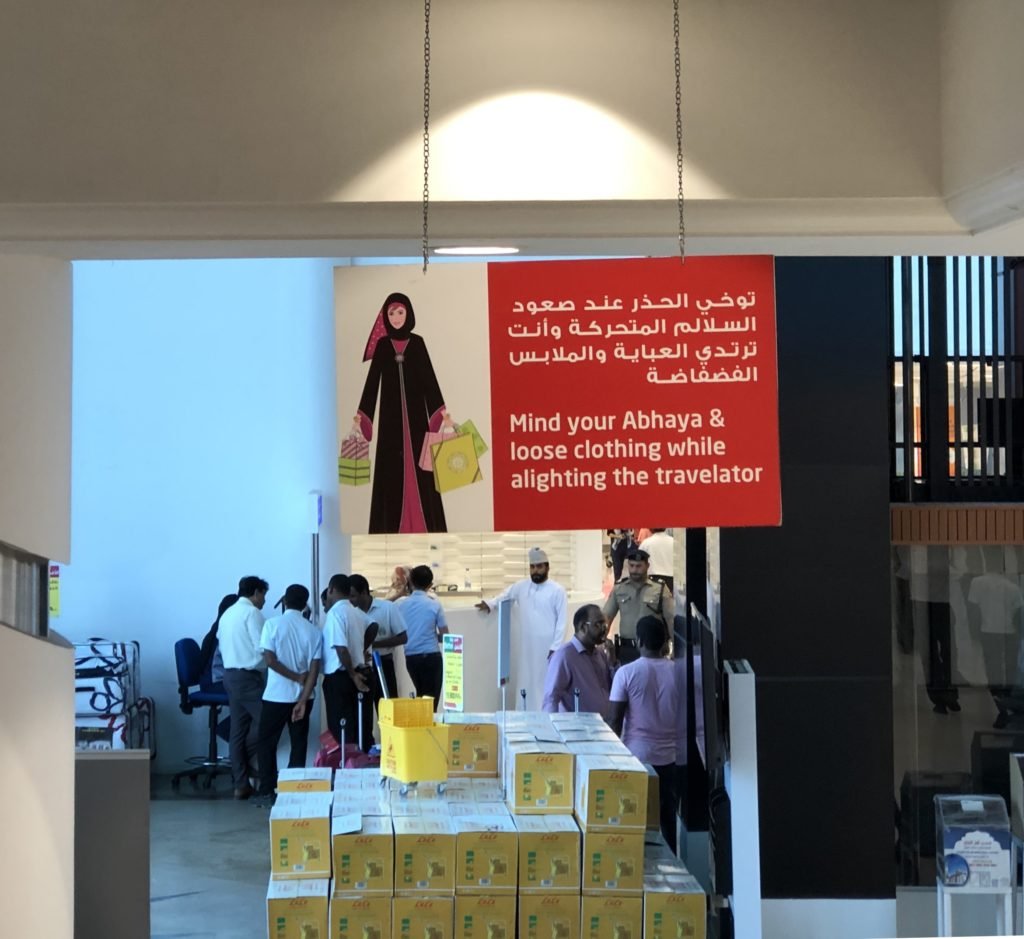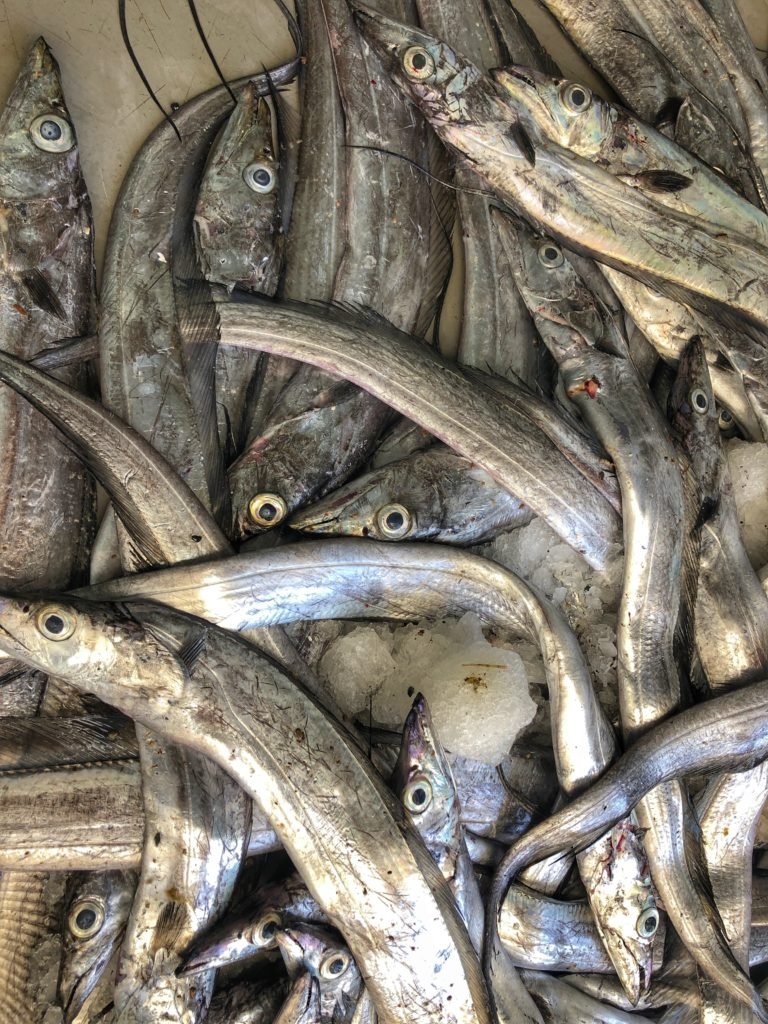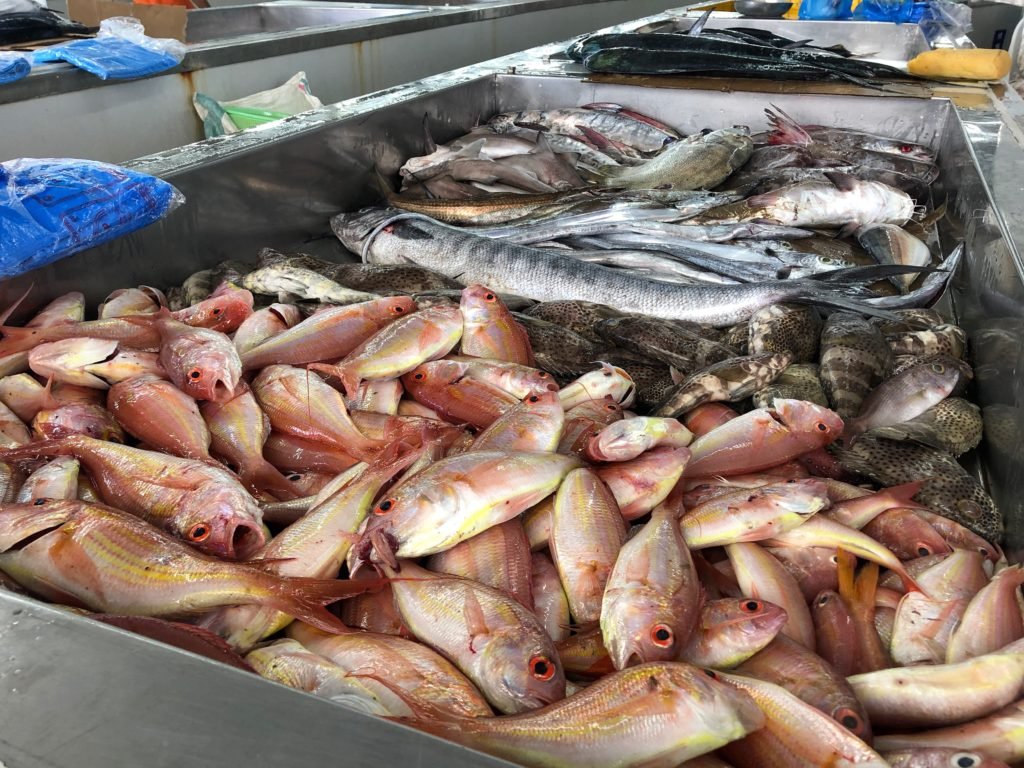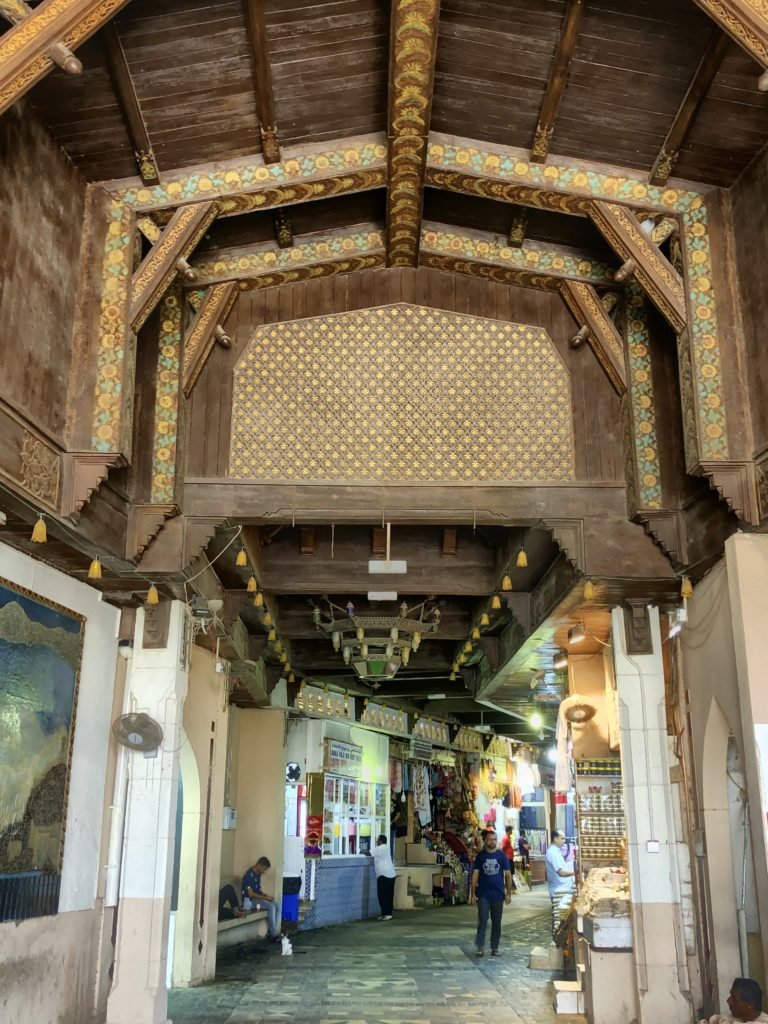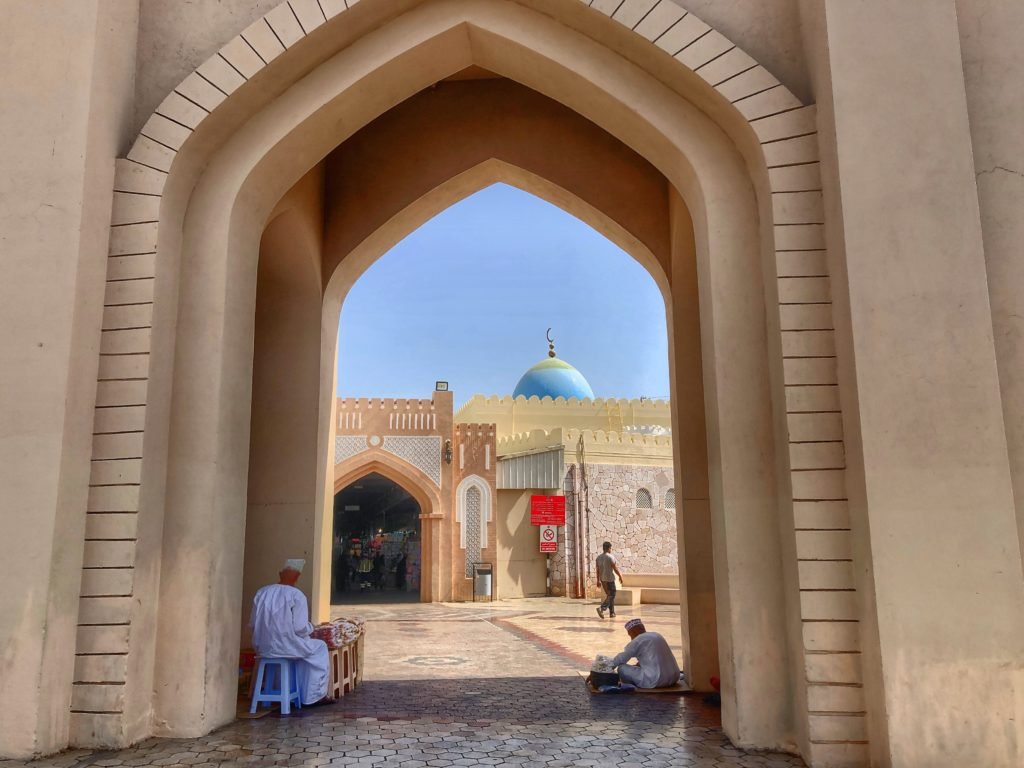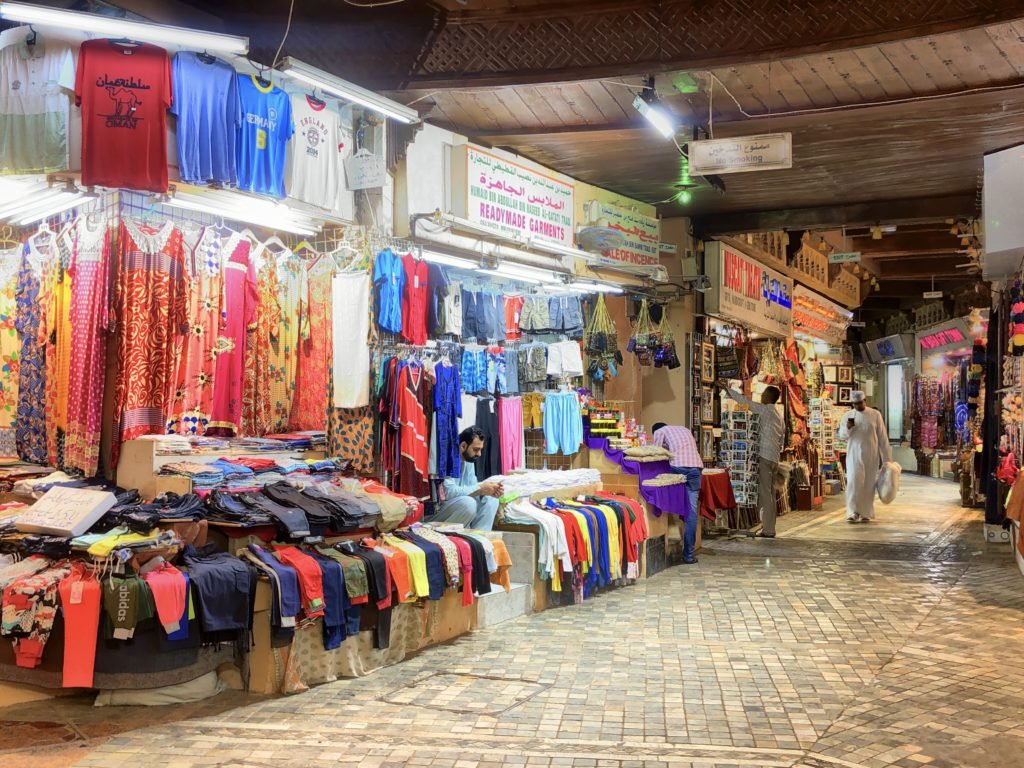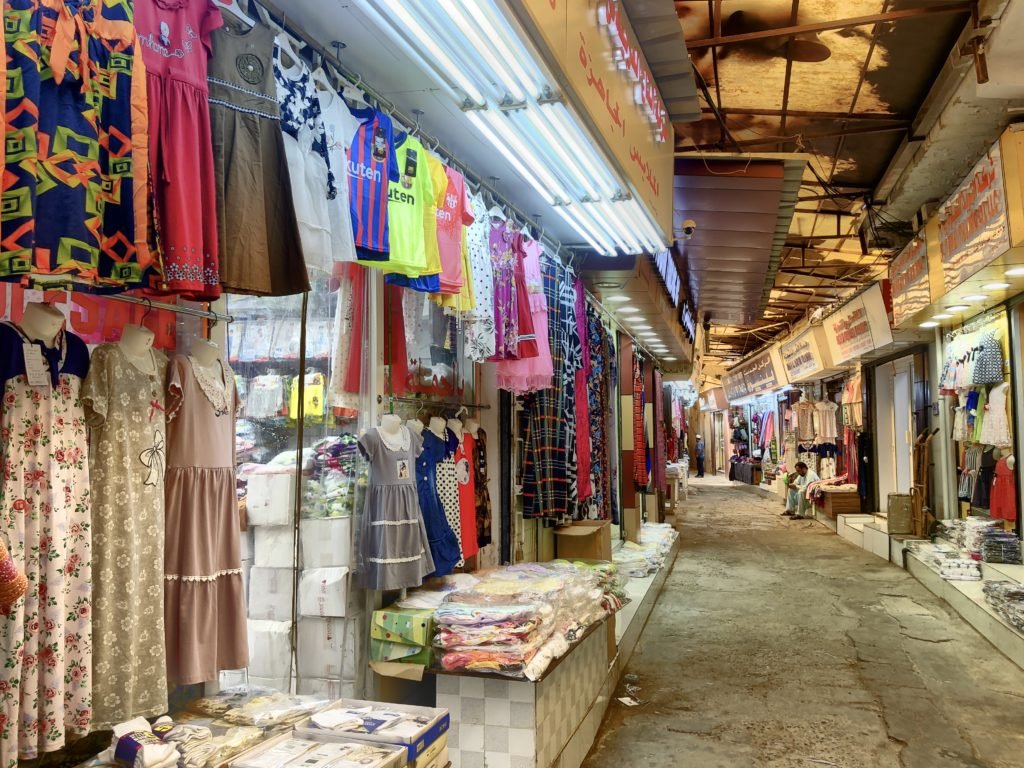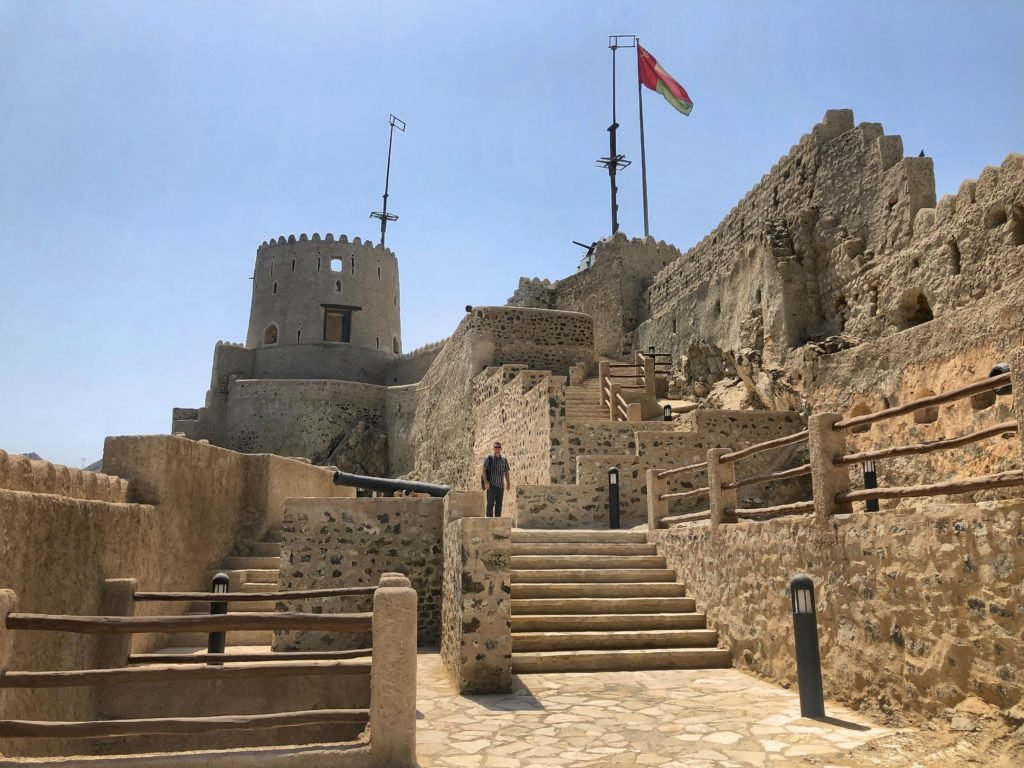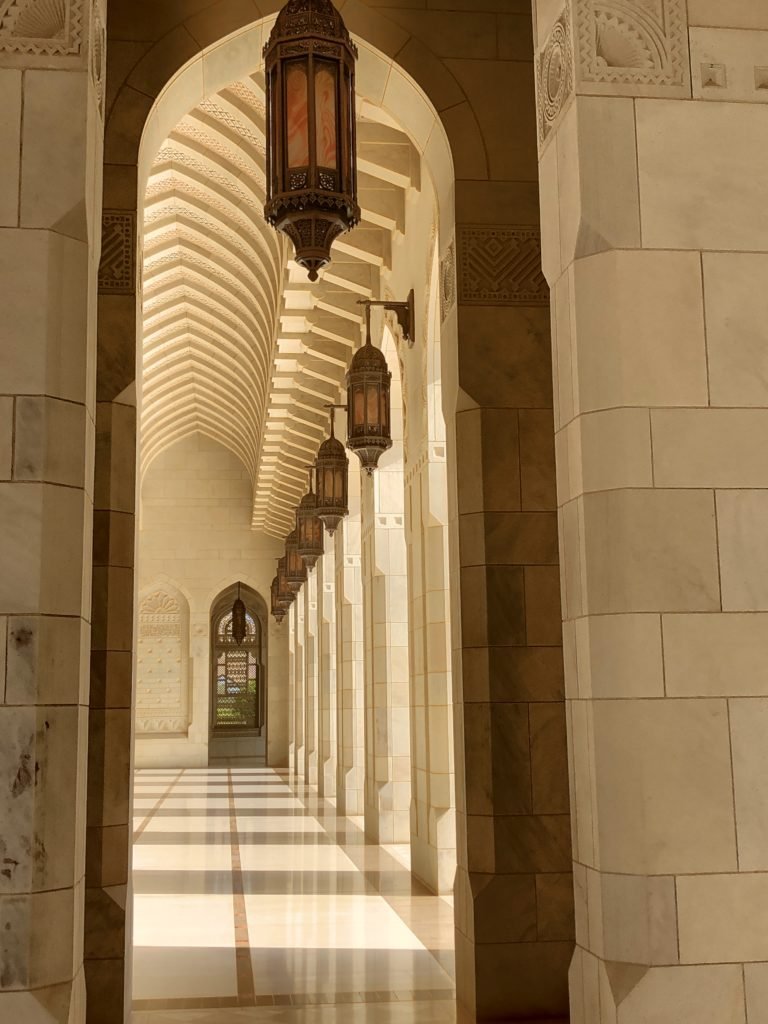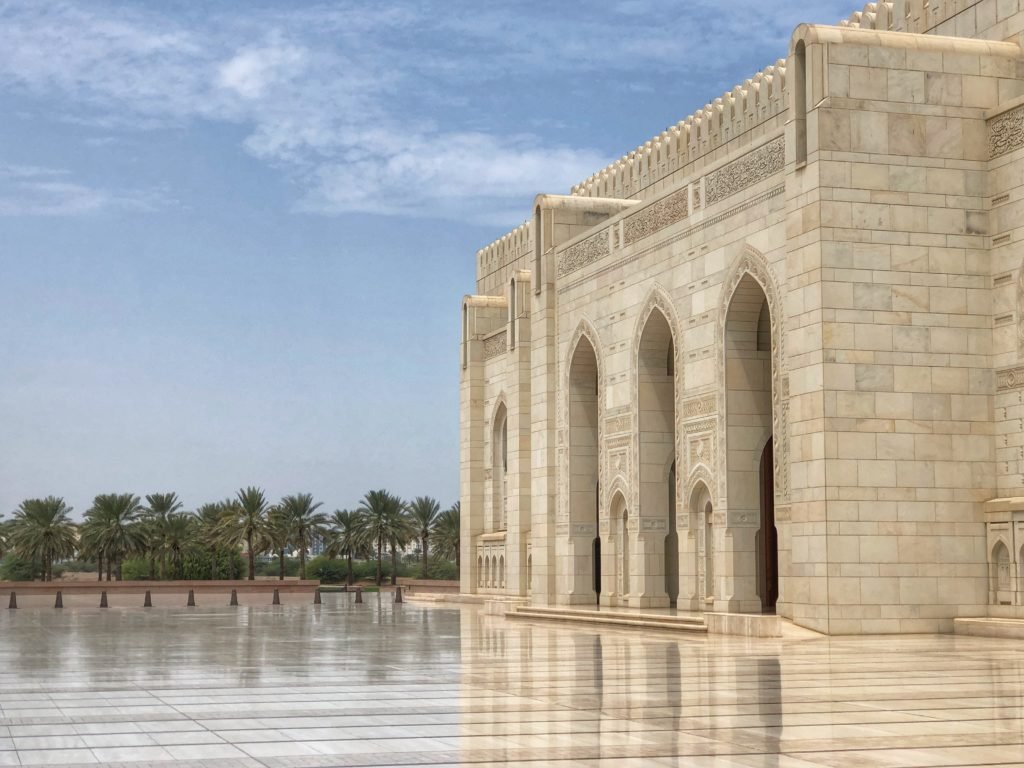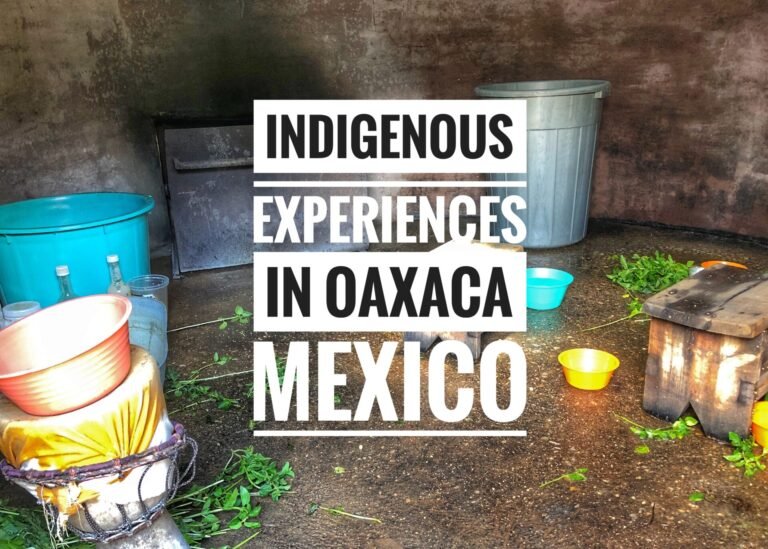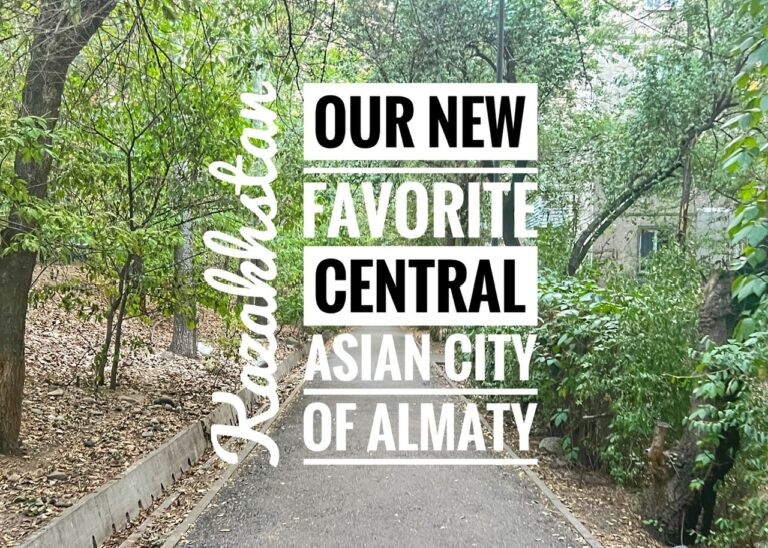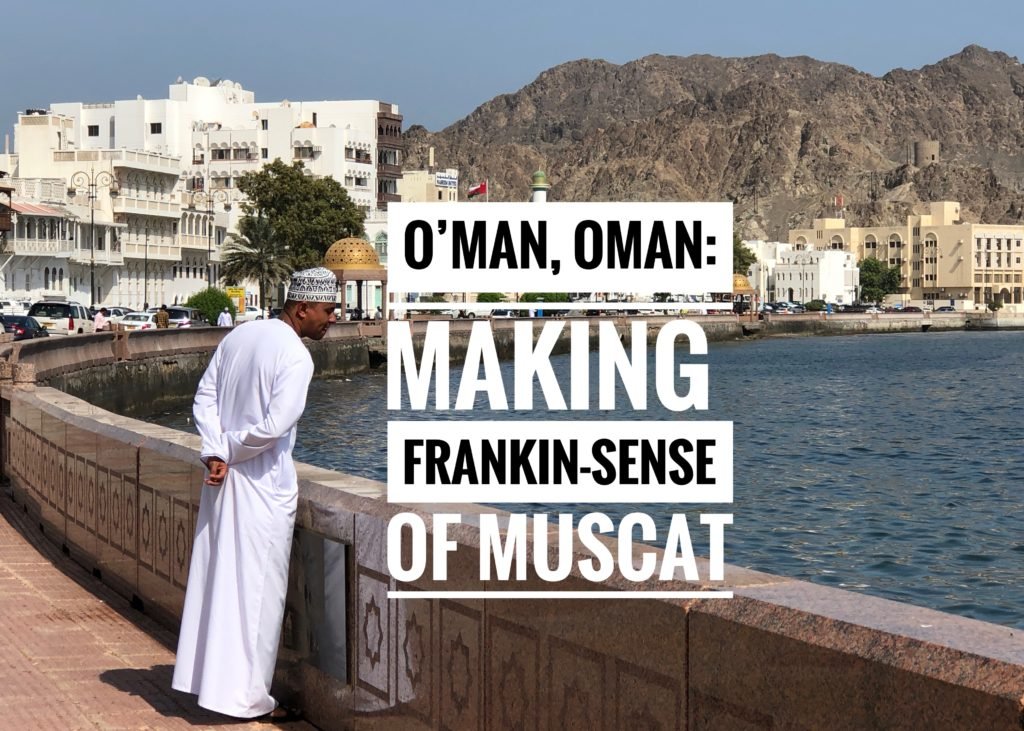
Because we’ve been in Europe for most of the past year, Oman is the first place we’ve gone that has felt truly and totally exotic. We’d already dipped our toes into the Middle East when we visited Jordan, but Jordan, is not as off-the-beaten-path nor does it feel as ‘traditionally Arab’ as Oman… not even close.
For westerners like us, when we imagine the antiquity and feel of a place like the Arabian Peninsula we envision fanciful encounters with the mysterious, and the exotic, as in the Arabian Nights. Images of caravans, spice traders and labyrinthine souqs, raw sun beaten desert landscapes punctuated by impossibly lush and green oasis and dessert forts. Oman, with its breathtakingly forbidding landscapes and still very much intact history and traditional ways of life on display, makes it easy to daydream of that storied Arabian past.
In fact, Oman’s entry into modernity is more recent than you would assume at first glance. Incredibly, until 1970, there were only 10 kilometers of black-top asphalt road in the entire country. The rest were just dirt tracks and passes. Today, Oman has built thousands of kilometers of top rate multi-lane divided highways to rival any of those you would see in a major western metropolis. Prior to 1970 there was also no or very limited TV, electricity, or radio options…making Oman kind of a land the modern world was passing by, a notion which is still seems prevalent in the mentality of some of the people. The difference maker of course in all this rapid development was, oil. However, the Sultan of Oman has taken pains to try and make sure his people do not lose their cultures values and old ways, or feel an entitlement from their oil wealth. We were quick to notice the Omani’s have a refreshing kind of naivety and pureness for the simpler joys in life. They seem content with things as they are. Literally, every Omani we met greeted us with smiles and a quiet respectful demeanor; touts or interruptions to our personal space/peace were infrequent and uncommon. In Oman, honking horns, raising voices (even talking loudly), or expressing anger is severely frowned upon and rare.
The idea of the rugged natural beauty and the strong cultural identity of Omani’s is what drew us to Oman… the feeling of complete safety, kindness, and respectfulness to our wellbeing only enriched our realization that this is indeed a special place to visit. In fact, the Omani are so peaceful, we’ve read they’re actively striving to be the “Switzerland” of the Middle East… we can see why, and they’re also currently rated a level one on the safety/travel index.
When departing from Istanbul, we settled into an empty departure gate while we waited for our gate to be assigned. The Istanbul airport quickly became one of the best people watching airports we’ve ever seen. Flights were departing and arriving from all over the world, and although we consider ourselves geography nerds, many destinations on the board stumped us for their country of origin. A world of faces and cultures were passing through it! Even more so when we came to our terminal, where the gates were assigned to places like, Jeddah (Saudi Arabia.)
We witnessed people rolling out prayer mats in the airport during Call to Prayer…
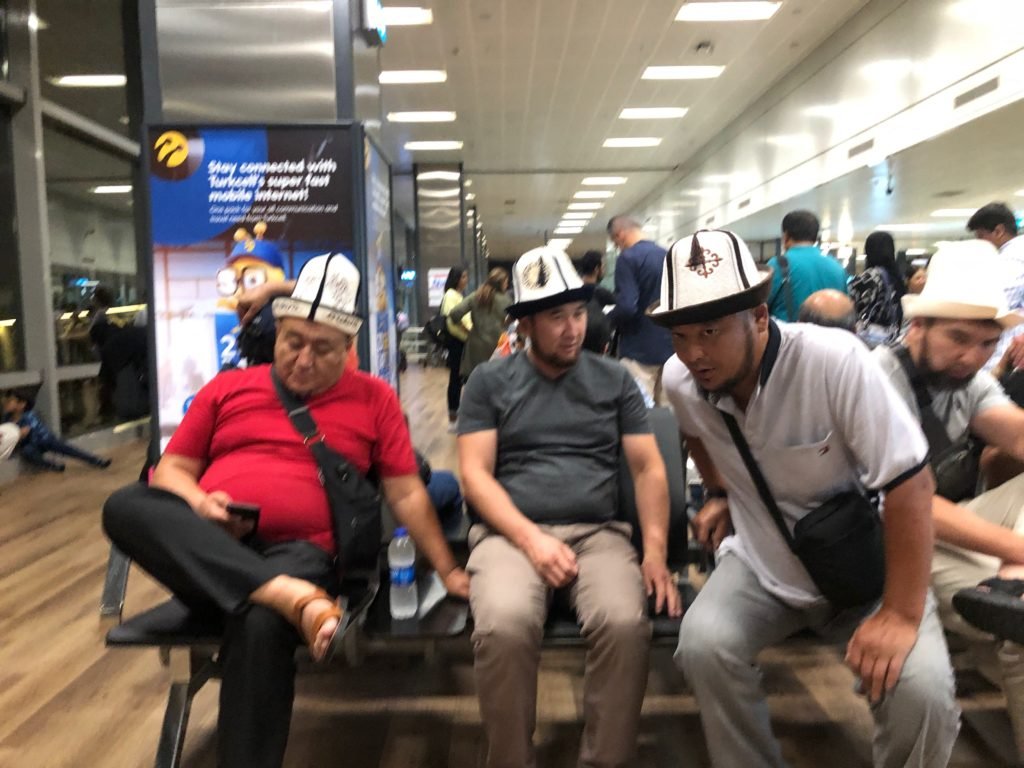
These guys totally stumped us. Not sure where/what the heck was their story might have been…
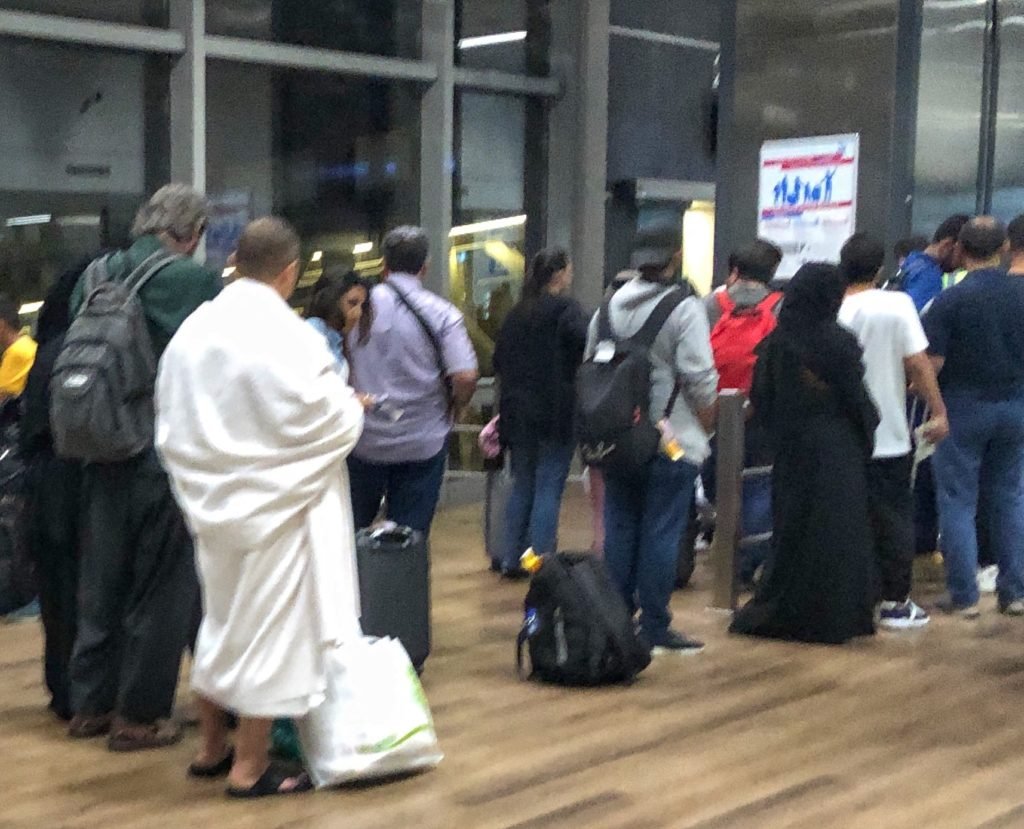
And here, we contemplated why in a departure lounge where nearly everyone was covered head to toe, why this one in white man seemed strangely to be dressed for a toga party, what you can’t see is the front of his outfit. It is totally open… like open, and exposed for all of us to see his hairy nipples.
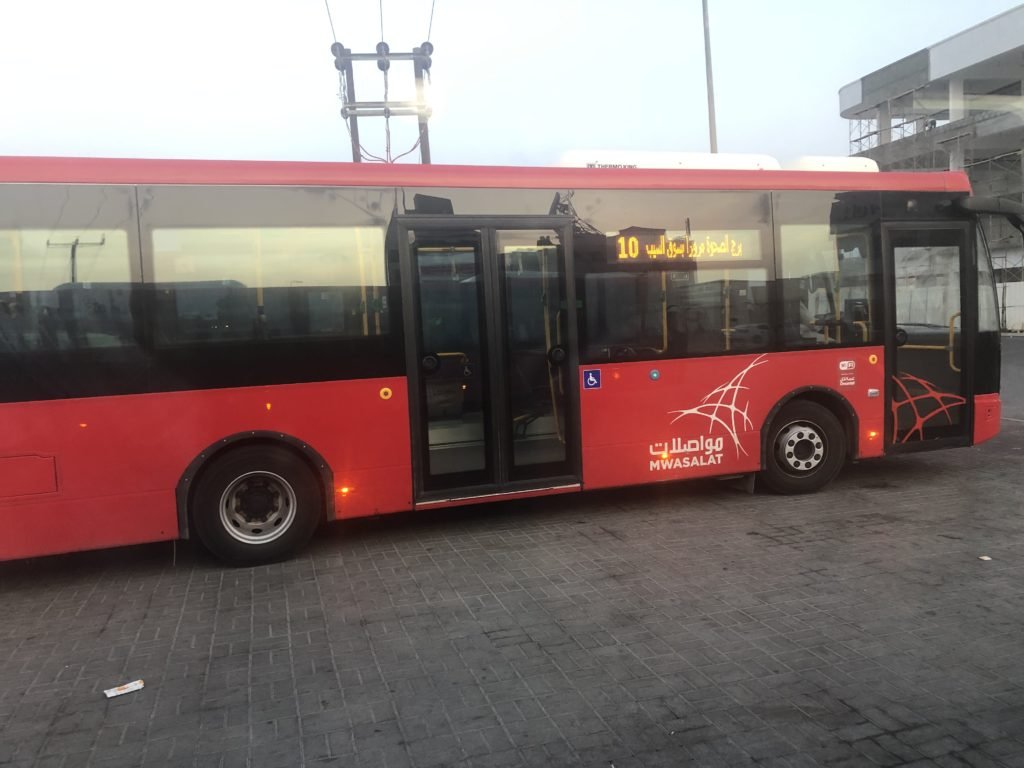
We arrived to Muscat at 5 am after our red eye flight and immediately hopped on the city bus 1A. Easy-peasy, we exclaimed. 30 minutes later we realized we took the 1A bus in the wrong direction. This is what sleep deprivation gets you. Muscat is a ridiculously spread out city, 50k from tip to tail, so after getting sorted out by the very helpful Omani bus driver and (overly) chipper passengers in their full-length white gowns (dishdasha) we were redirected onto to the correct bus.

Once on the correct bus, we got to where we wanted to go but… when we stepped off the bus we realized we were dropped off literally on the side of the freeway (during rush hour) because it was a “freeway stop” meant for transfers … and we were stuck. Hemmed in by impassable speeding cars and a watery canal. Not exactly pedestrian friendly! Despite this, we immediately noticed it feels very clean, safe and modern.

So, How to get off the freeway?! There has to be a way! Ah, there it is. Somebody had cobbled together selection of building materials to make a footbridge to cross the canal. All we had to do was maneuver across the blocks and then scale the concrete wall on the other side using the provided plastic tubing as a rappelling/ascending lifeline. We wish we had video to show, because it was quite a feat! Can’t believe we didn’t lose our balance with our packs!! ? Surprisingly, the water was super clean, and clear, and even had fish in it!
We were already starting to simmer and drip with sweat in the heat at 7 am, so we were relieved to arrive to our little Omani home for three nights. We were pleased to discover we had some wonderful Filipino AirBnB hosts, Vincent & Dolly. It was $29/night. Prices are definitely less budget friendly than we were used to in this oil-rich nation. It’s not often you demand a cold shower over a steamy hot one but the extreme heat bakes the pipes and water lines so even a tap set on full cold gives you 100F+ degree tap water. This was to be a strangely frustrating challenge throughout the country.
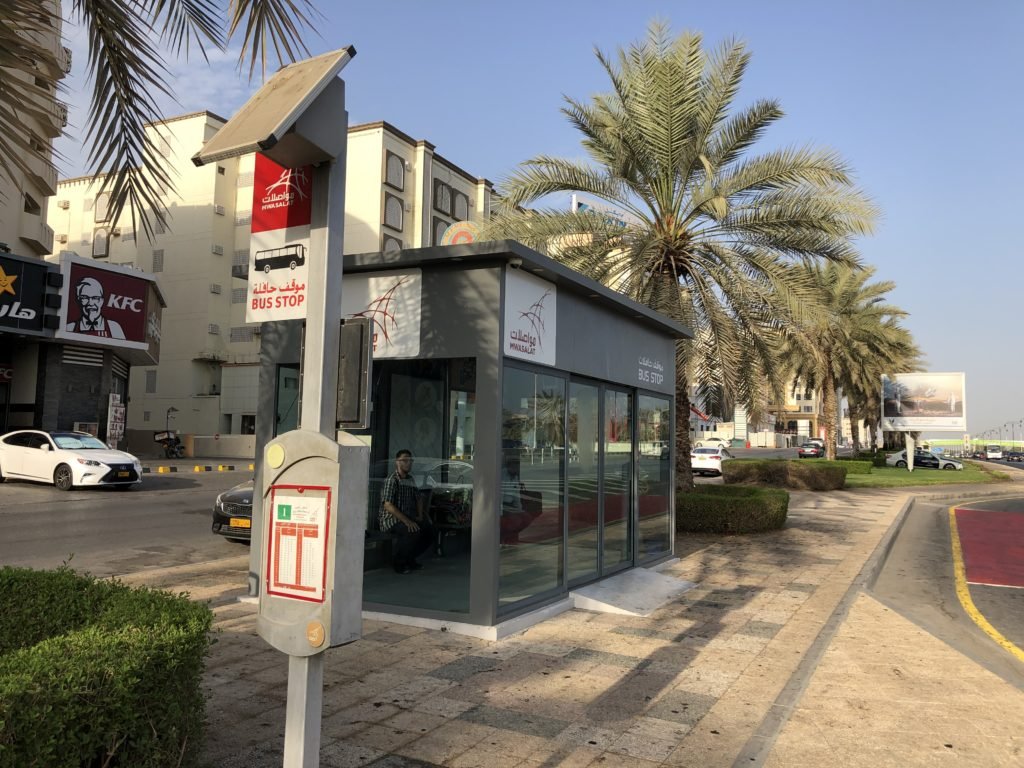
For the record, later that day, when we ventured out we located the bus stop we should have used earlier, and it was even air conditioned! With the air conditioning so strategically placed, we constantly felt like we were in a spa ambling from the sauna to the ice cold plunge pool. (Okay, it wasn’t as inviting as a spa…but what a way to spin it, eh?)
Everything is in English. And by that, we mean very basic, literal English. Who needs a bakery when you can have “sale of bread and bread products?” Also, any quality graphic designer would shudder at the notion of this nightmarish mono-font land.
The culture shift was obvious. Societally, one of the biggest observations we made immediately was the strict lines of decorum between men and women. The stares were prevalent, particularly at Mandy. Otherwise…
- When boarding a bus, most of the time you’ll only find men on board. When there are women, they are usually separated from the men and sit at the front; in the section deemed specifically for women and children.
- This same separation of the sexes scenario happens at restaurants… if it’s a husband and wife (or only women and children, no men) you are supposed to enter through the “family entrance.”
- In all Omani households, there is a “reception room” at the front of the house, with a separate entrance door, where the man of the home may receive guests. The rest of the home is designated for women and children only.
- Women should not shake hands or touch with any men as it can be perceived as sexual interest. If a man tries to shake a woman’s hand, the proper thing for the woman to do is refuse the handshake and instead place a hand on her heart and bow her head. Mandy had to tone down her normal friendliness, which wasn’t easy.
- Women should definitely not handle any money in a man’s presence. This would be very taboo.
- Men always should ride in the back of a car/taxi if there is a woman present or entering the vehicle. Men should not be seated next to women unless they are married or closely related.
- We also learned that Omani men in particular have many household and societal responsibilities. In addition to being the sole provider of money, he is the one who is responsible for paying all the household bills, doing any banking or taking care of any maintenance or household upkeep of anything, he also plays a very active role in doing the shopping and, ahem, has to carry all the bags or push the cart around the store. Women should not carry bags (or really anything) in a man’s presence.
- All the man’s money is family money… it all goes towards the household and family expenses. Women are actually free and even encouraged to hold a job if they wish it, but differently from the man any money the women earns is explicitly theirs to spend or save as they wish. Only the women have/own gold, they also usually receive it by their husbands as a dowry for a marriage; typically this is about 20,000 Omani Rial ($51,000). Men typically only wear silver, including their wedding ring. The hoarding of gold is essentially seen as the wife’s nest egg, a “life insurance” and is a tradition that goes back centuries to a time well before modern day banks existed.
- Although some of these cultural norms and divisions between the sexes in Oman may seem oppressive to westerners, after the initial shock of it, Mandy admitted she enjoyed shedding responsibilities and having Greg step up to be her bag boy, driver, bill payer, gold mine, and errand boy. (But for the record, when moving our large backpacks around, Greg did “allow” her to carry her fair share, and although he may have received some questioning and emasculating stares, Mandy knew he was far from lacking in his “responsibilities.”)
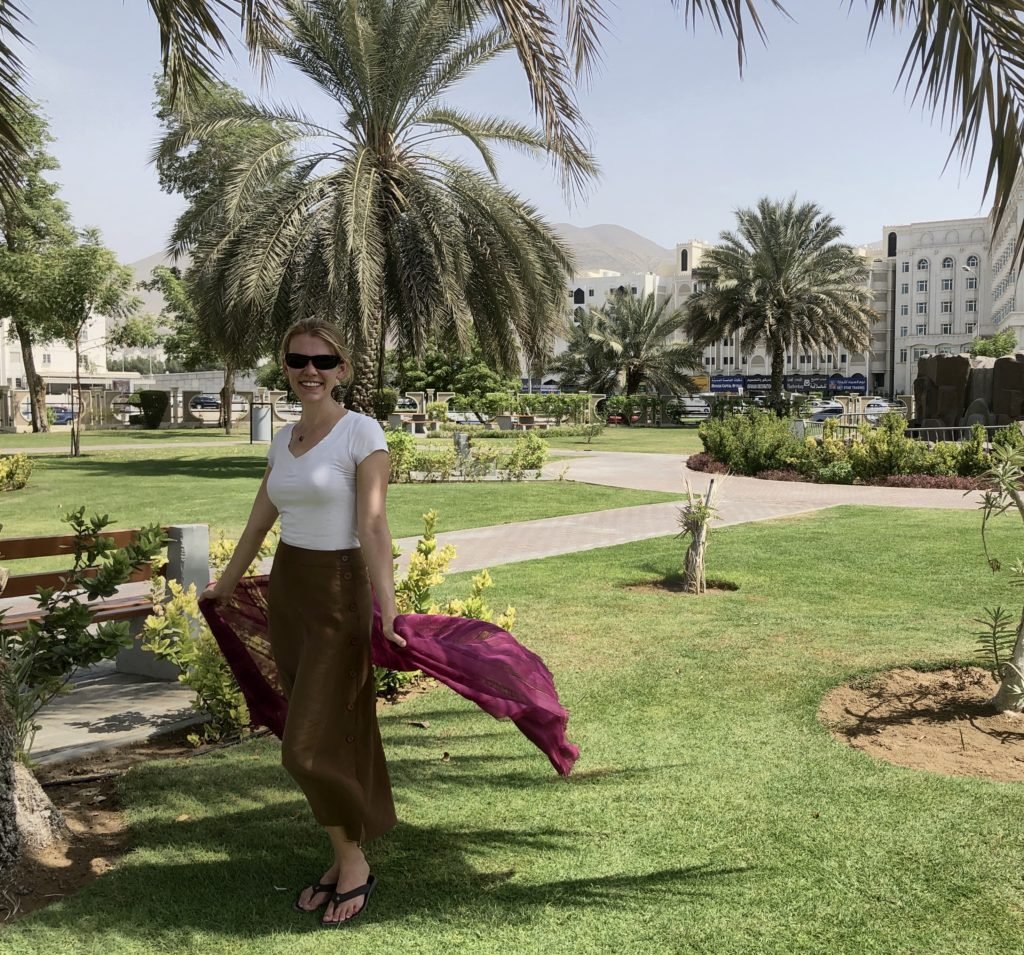
While Mandy never tried on an abaya, she did get to try out her “conservative” attire, which usually meant covering below the knees and shoulders. Two big sins of the flesh in the Middle East are exposed shoulders and thighs. Heads only need be covered when entering a mosque or holy site. She sneaks her scarf down in a park for a photo opp. That said, being modest is important in this society, even outside of mosques. And to be honest, we learned that long-sleeve cotton clothes WERE actually more cooling than shorts and a T-shirt. The key is actually sun avoidance and ventilation, with loose fitting long sleeves and pants you get both! These Arabs and their full length outerwear know what they’re doing…
Getting glimpses of the early morning catch hauled out of the Indian Ocean.
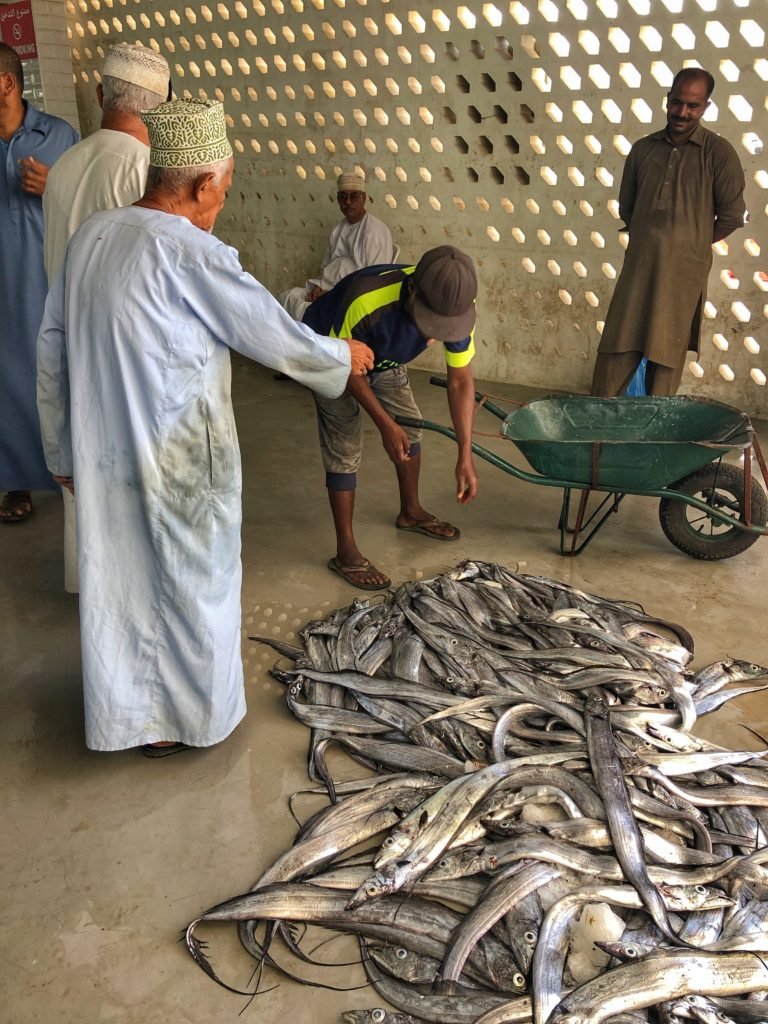
This Omani is clearly in charge of this worker at the fish market.
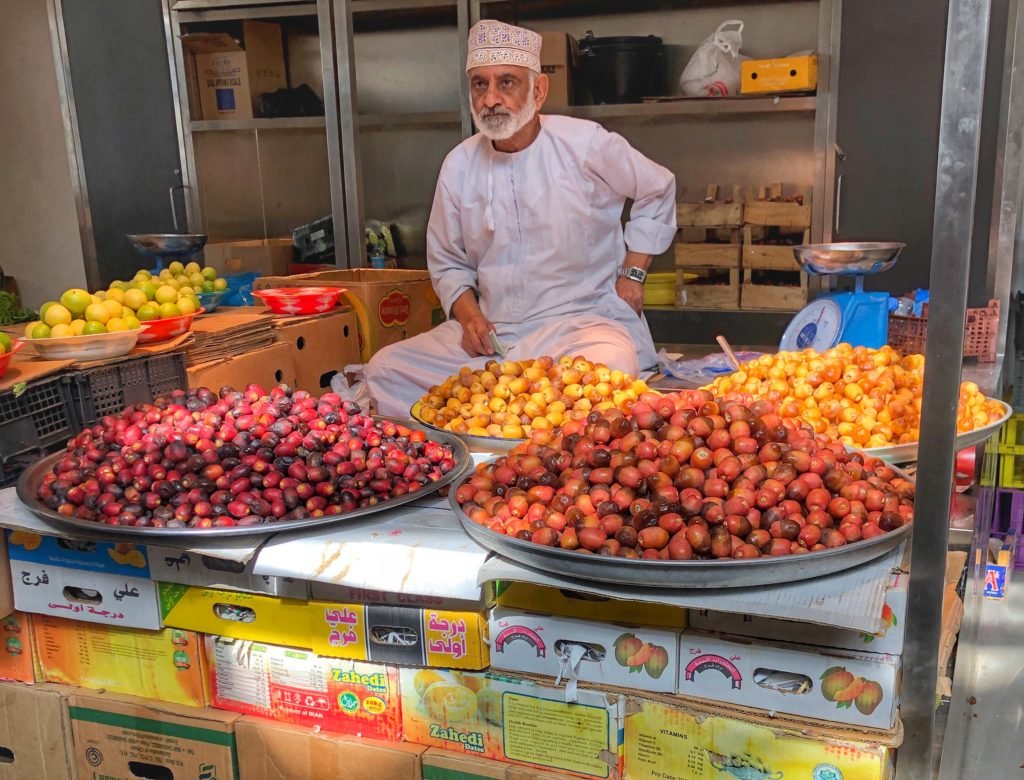
A date salesman displays four of the more than 200 different kinds of dates. He’s wearing a kumar cap, which is traditionally embroidered by a loved one, and commonly worn by the men in Oman.
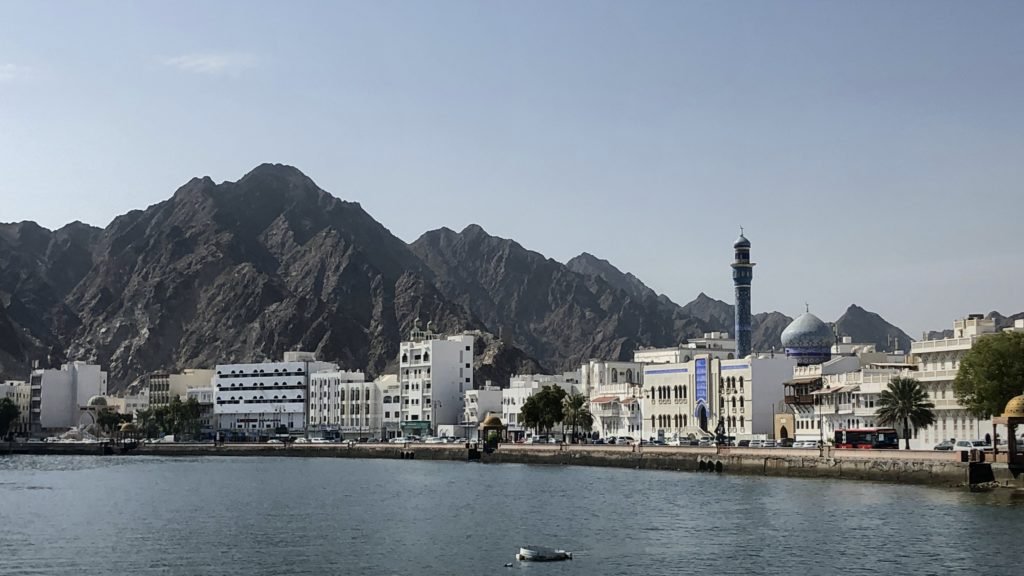
The corniche (oceanside promenade) of Muscat. The corniche are common features of seaside ports in Arabian countries.

A man walks down the corniche in the typical attire for men in Oman, a dishdasha. It is a single piece of clothing, with a skirt that drapes down to the ground. (We didn’t check to see if there is an undergarment!) There are a variety of forms of this traditional costume throughout the Middle East. Some are also just long tunics with pants instead of the skirt. We initially thought they were religious in some way, but we learned they are not. They are just practical…and no doubt the result of generations of use. Made of cotton/linen, they make sense in Oman. It was almost counter-intuitive to us, but we quickly found that to beat the heat here the key is to keep the sun from scorching your skin. So, oddly wearing light colored loose fitting long sleeves and pants actually feels better (less hot). It’s all about keeping the air-circulating and protecting you skin and head.
The men wear their dishdasha everywhere, everyday with little exception. This includes the middle of the night at the airport. In fact, we gazed at them enviously because they all looked like they were comfortably lounging in around in their jammies. Seeing the Omani men in their dishdasha was a constant reminder of how foreign a place this was. However, Greg opted not to don one, (our guidebook suggested to avoid wearing them because… at best, Arab people think it looks… “ridiculous” on foreigners.) Making us to ponder what is “at worst?” ?

Surprisingly we didn’t see many older people in Oman, but this little old man on the bus was just adorable. His dishdasha is enhanced by a colored turban made of pashmina and tied “according to tradition.” He also sports a traditional curved silver khanjar (dagger) tucked into his belt and a short simple camel hooked stick traditionally used by shepherds, also handy for swatting away any nasty creatures in the desert.
Two different entrances to the Muscat Souq.

Although we’d just visited the bazaars in Istanbul, entering our first Omani souq was a radically different experience. The most notable thing was the ever present fragrance wafting in the air wherever we meandered…a delightful incense billowed from the shops filling the souq with a mystical perfume that was earthy, musky, and spicy and totally foreign to our noses. We only knew the aromatic delight we were smelling was frankincense because we had read to expect it. We, of course, know about this exotic and precious gift from southern Arabia because of the Christmas story that says Baby Jesus received it by the Three Wise Men. Oman still produces this truly ancient aromatic resin derived from the Frankincense tree which grow on its southern border with Yemen. It is said that frankincense can help as a labor aid, so undoubtedly Mary was appreciative, even though Baby Jesus probably didn’t know what to do with it. (Bonus, they sold Myrrh in the souq too!)
In the Muscat souq we were pleased to discover a distinct lack of touts and high pressure salesman that we had encountered in other Arabic/Middle Eastern bazaars and marketplaces. We were left alone to wander through the winding alleyways and leisurely browse with only the occasional offer to “take look inside” a shop. This led to the question, what’s the difference between a souq and bazaar? It turns out, not really anything according to Wiki. Souq is just used mostly in Arabic speaking countries and bazaar is used in non-Arabic speaking countries.
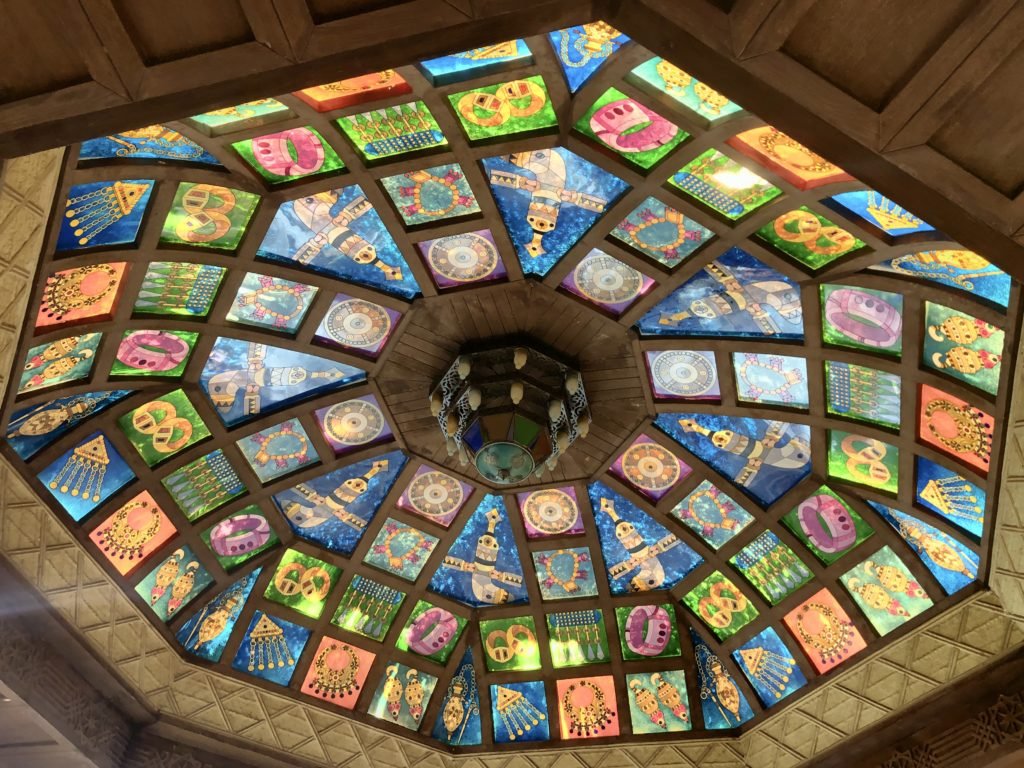
One of gorgeous stained glass ceilings inside the souq.
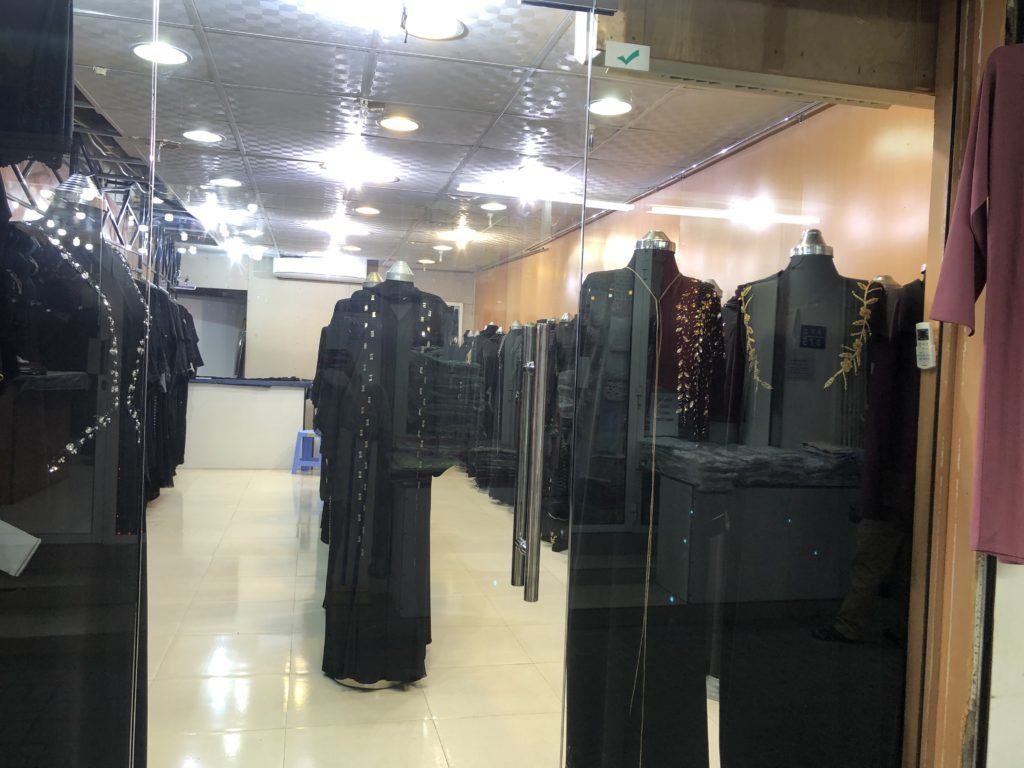
An abaya shop. Abaya tailoring seemed to be one of the most prominent shops around the country.
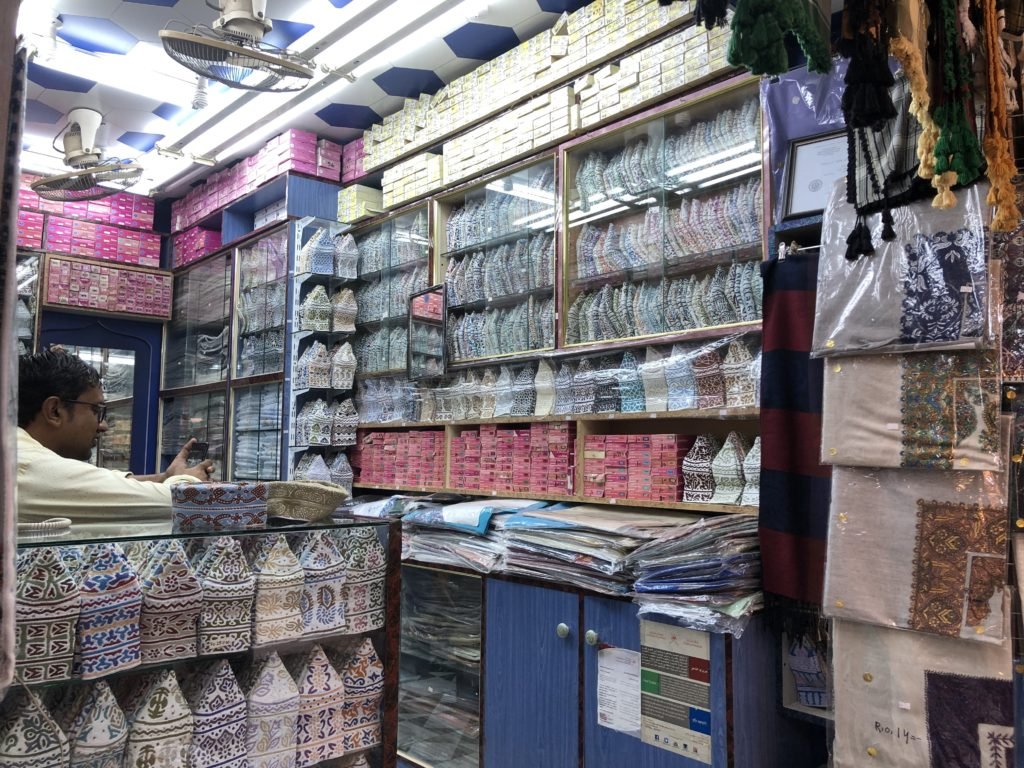
A kumar cap store. Men don’t usually have these kind of accessory options!
The dramatic Mutrah Fort on the harbor in Muscat was built by the Portuguese in the 1580’s. Our guidebook said it’s normally closed and used for military needs only but we got lucky when a guard invited us up to tour it for free. Interestingly, the Omani coast is blanketed with influence from the short-lived Portuguese colonization in the 16th century.
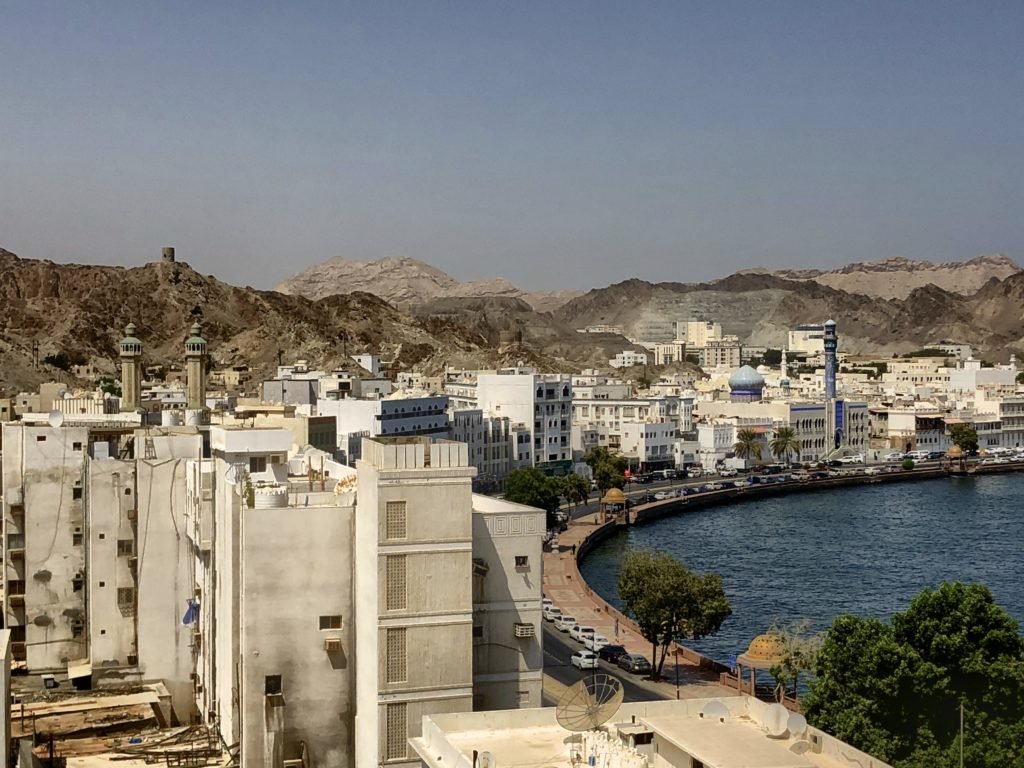
The view of Muscat from the fort.
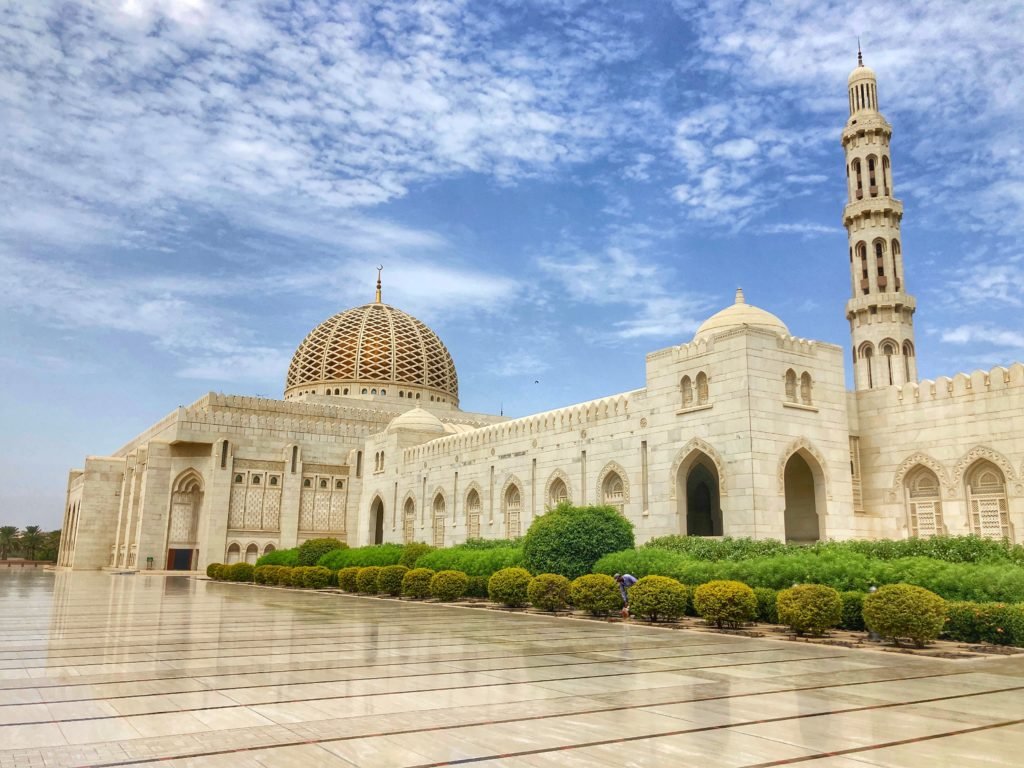
Time to visit the Sultan Qaboos Grand Mosque!
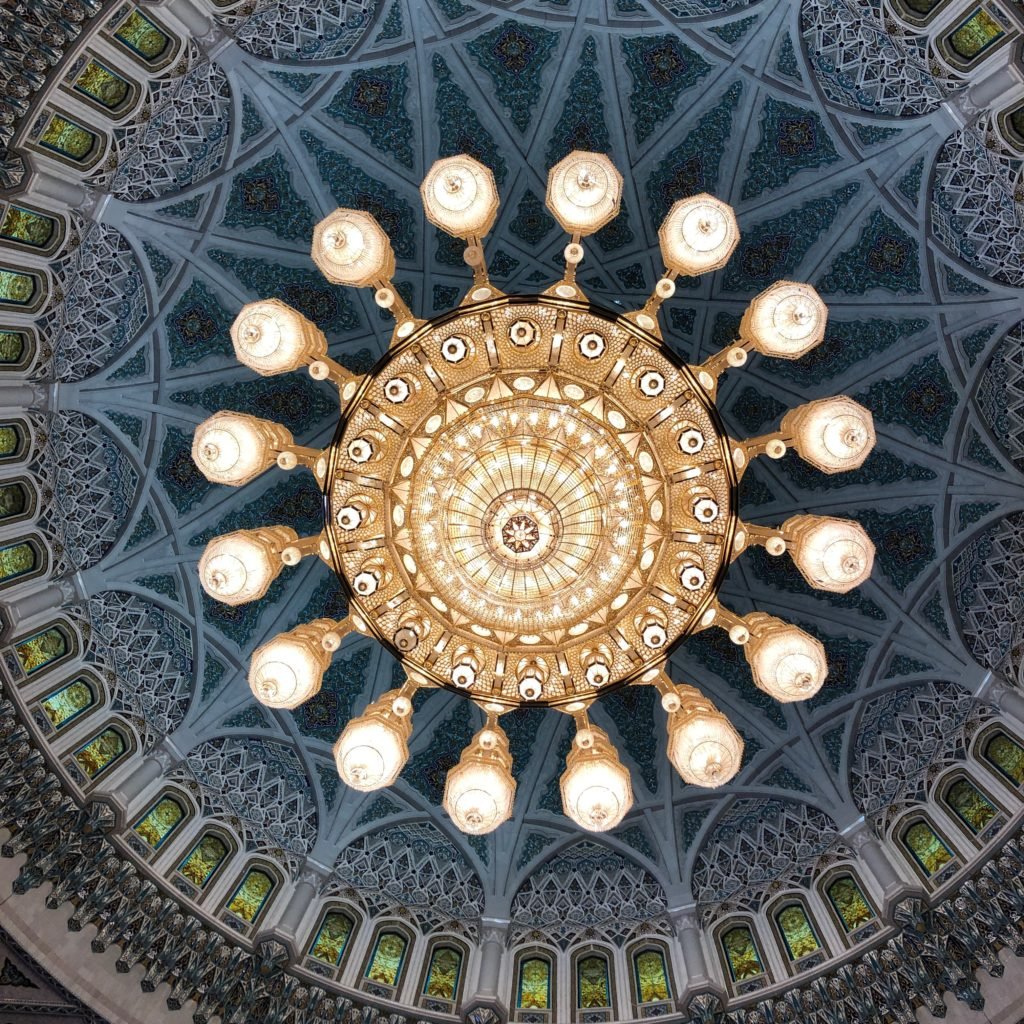
Sultan Qaboos Grand Mosque in Muscat is perhaps one of the most visually arresting holy sites we’ve ever seen. This contemporary Islamic masterpiece radiates with opulence, energy, and jaw-dropping floor to ceiling magnificence. Upon entering the main dome (musalla) your eye inevitably is drawn upward first and foremost on the eight-ton Swarovski crystal chandelier, before then looking downward at your feet and taking in the never-ending handmade wall-to-wall carpet with its intricate details and immense size which fills this massive room. This (unaltered) image displays the raw beauty of the chandelier from the ground up.

The German made frame of the chandelier is 14 meters tall (46 feet), holds 600,000 Austrian crystals, and weighs an incomprehensible 8 tons.
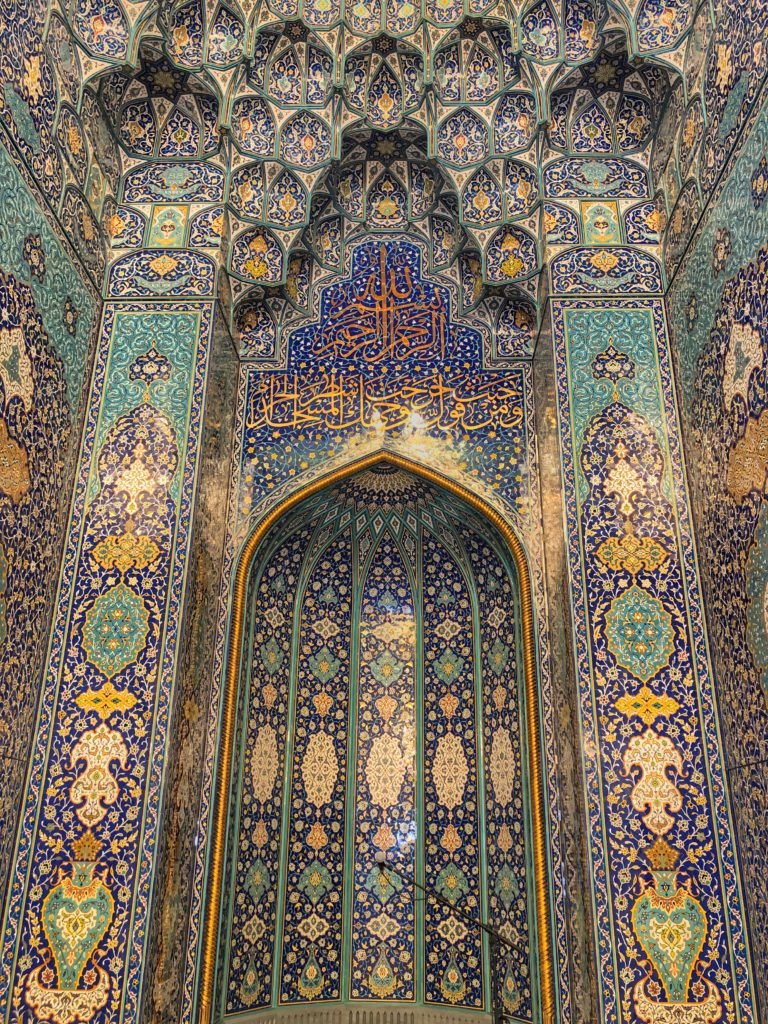
The mihrab, or prayer niche which indicates the direction to Mecca.

The entire dome. It’s mesmerizing. Again, these are unedited pictures.
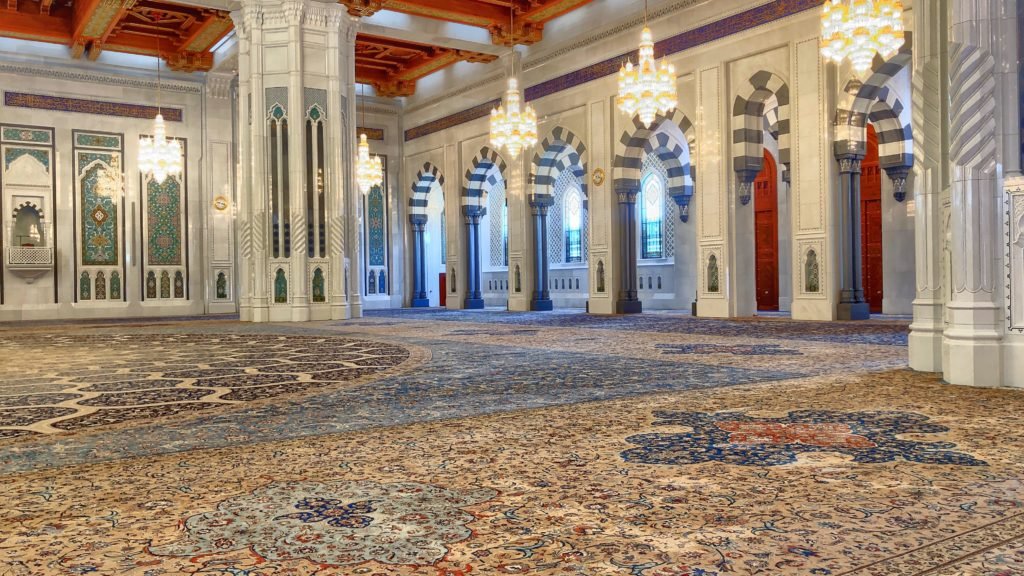
The incredible carpet was made in Iran with 1,700,000,000 knots, weighs 21 tonnes and took a team of several dozen Iranian weavers four years to produce. 28 shades of color, from traditional vegetable and plant-based dye were used to make it. It’s the second largest single-piece carpet in the world. (UAE had to outdo it, naturally). There is a runner down the middle for an extra layer of protection when visitors are allowed to come in during the non-prayer times of 8-11am. Shoes are of course are a big no no in all mosques… however we overheard a guide scold a foreign visitor who failed to take off his shoes.
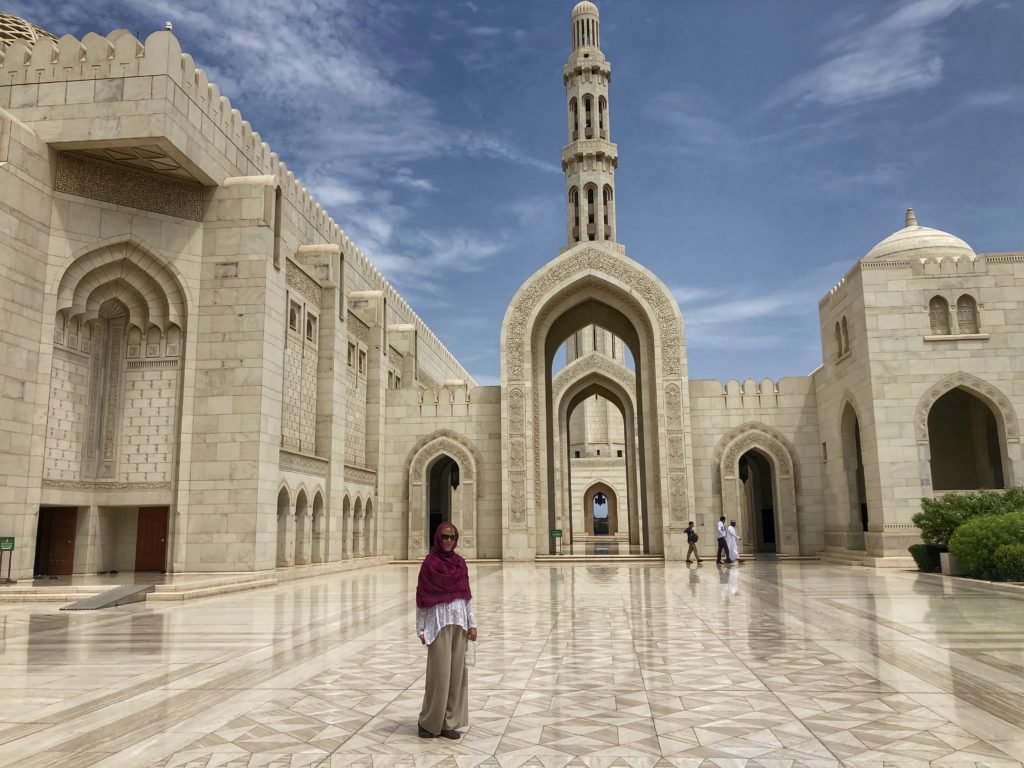
Speaking of no no’s, the guards at the entrance gently stopped Mandy before entering saying “shirt…translucent…no good”
Mandy’s long-sleeve shirt was apparently too see-through so Greg helped to wrap up his miscreant wife extra tight with her scarf to cover the unacceptably see-through parts. We got smiles and a thumbs up from the guards and could now enter the mosque compound. Interestingly the Omani belong to a sect of Islam called Ibadhi, different from the more common Sunni and Shia sects elsewhere in the Middle East. We read the Ibadhi are said to be the “most tolerant” of the three sects.

The mosque was built from 300,000 tons of Indian sandstone. Not to mention the imported Italian marble everywhere!!
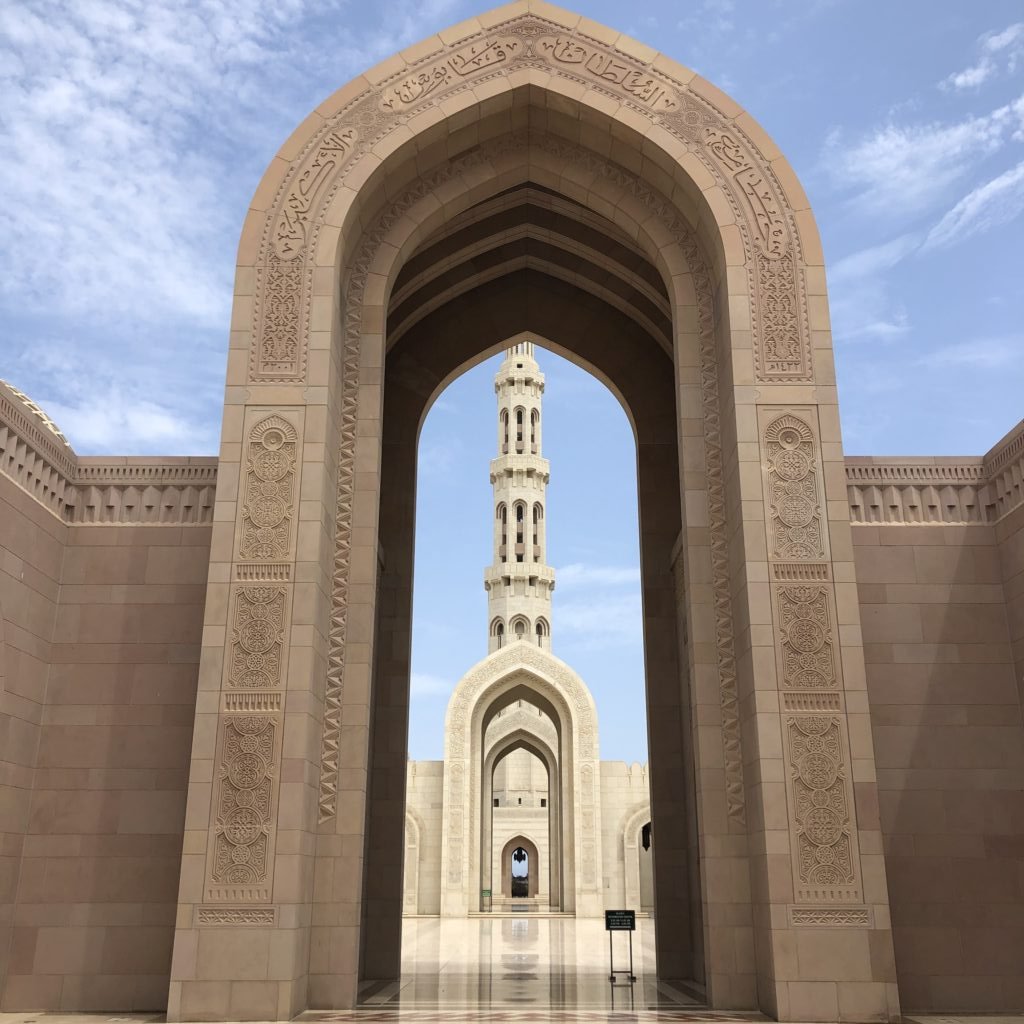
It’s easy to admire the beautiful simplicity of the arch here, showcased by these exposed lone arches. Truly stunning architecture!!
More snaps of the mosque’s architecture. The marble is truly just stunning..
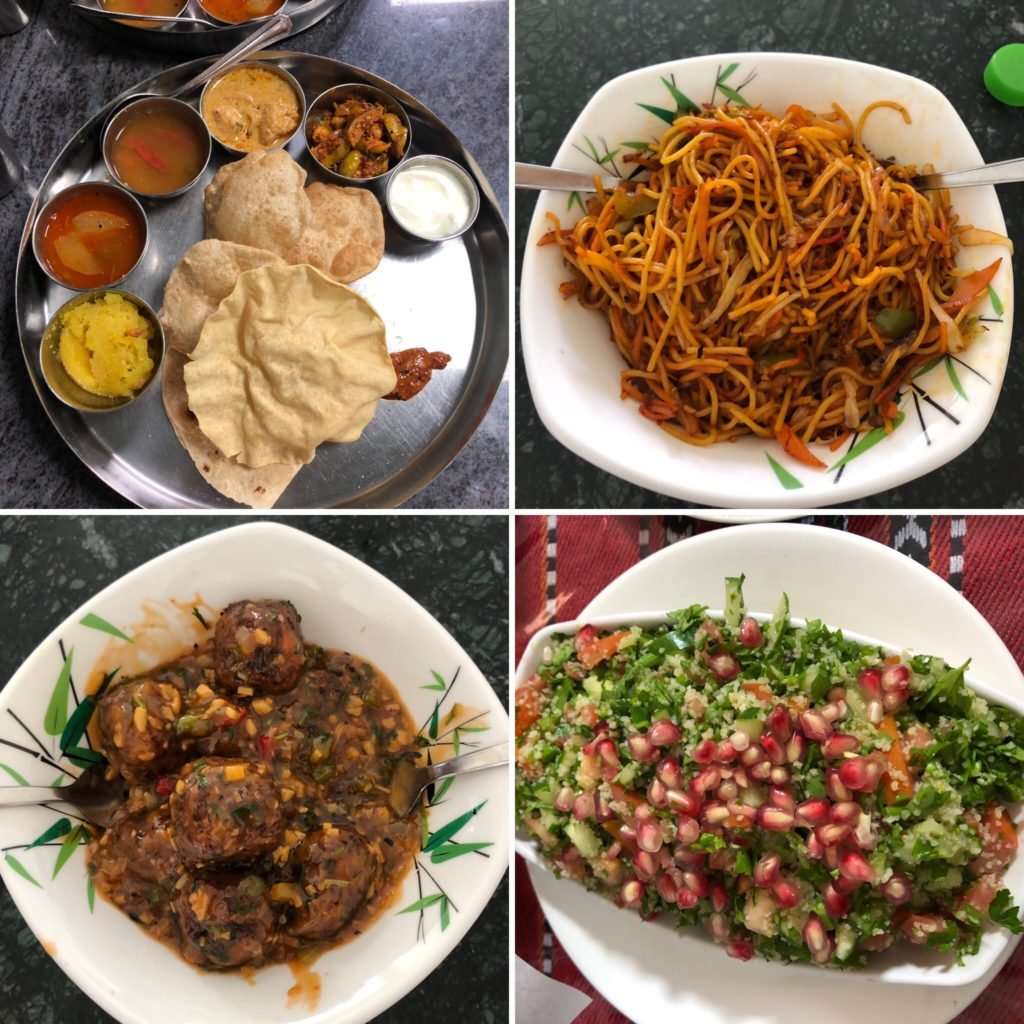
After a morning of mosquing, we managed to work up a strong appetite for some lunch… Indian Thali in this case ($1.50) (Top left). For those keen on world cuisines, you’ll know the Thali to be an Indian staple at mealtime. But in Oman, Indian food is easier to find than Omani. After so much time in Europe, we were absolutely delighted to encounter the plentifully spice laden Indian and Asian exotic food options all around us. Interestingly, in Oman, and nearby U.A.E., this is due to the large amounts of Indian, Pakistani, and Nepalese immigrants, who have come to the Middle East for work. Everyday there is a veritable army of these expats who brave the intense heat to keep the parklands and manicured streetscapes of Muscat green and pristine. And yes, we’ve already got a little dose of Delhi Belly out of the way… (Oh, but it’s so worth it…) We also had some Chinese and Syrian grub also for around $1.50/plate.
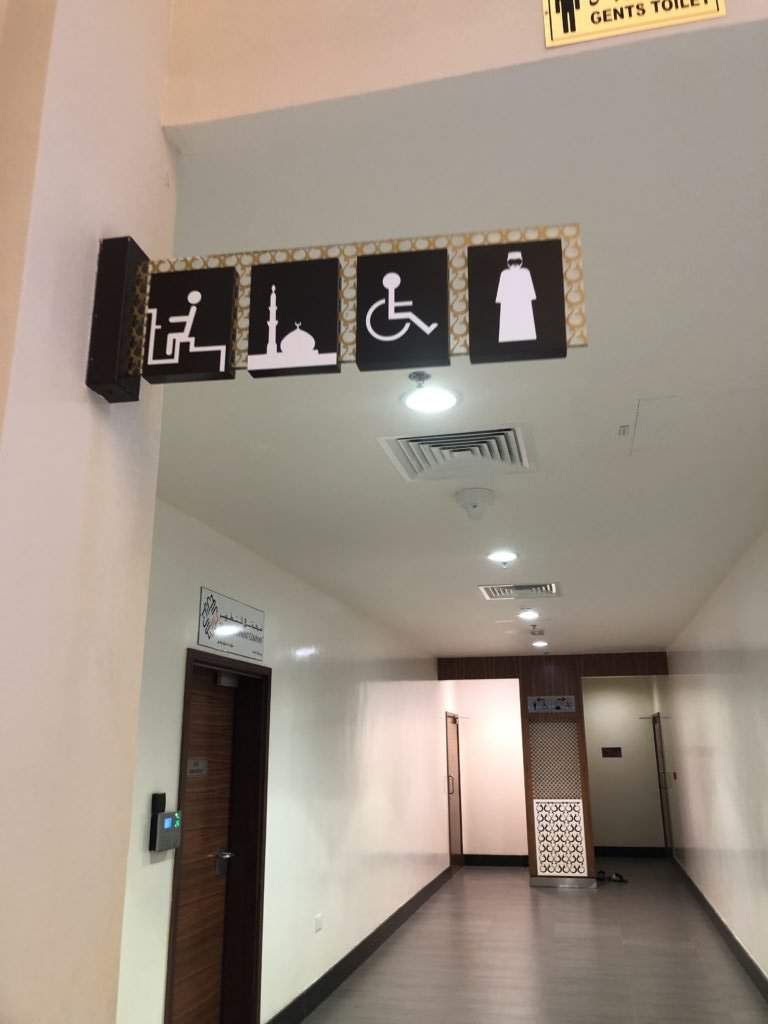
Pop quiz! Is this a men’s or women’s restroom?!

The giant incense burner on top of the hill in a Muscat Park. Also, notice the flowing pot fountain art in the center of the roundabout. In nearly every single roundabout in Oman is some kind of art installation. We saw boats, fish, stars, you name it!
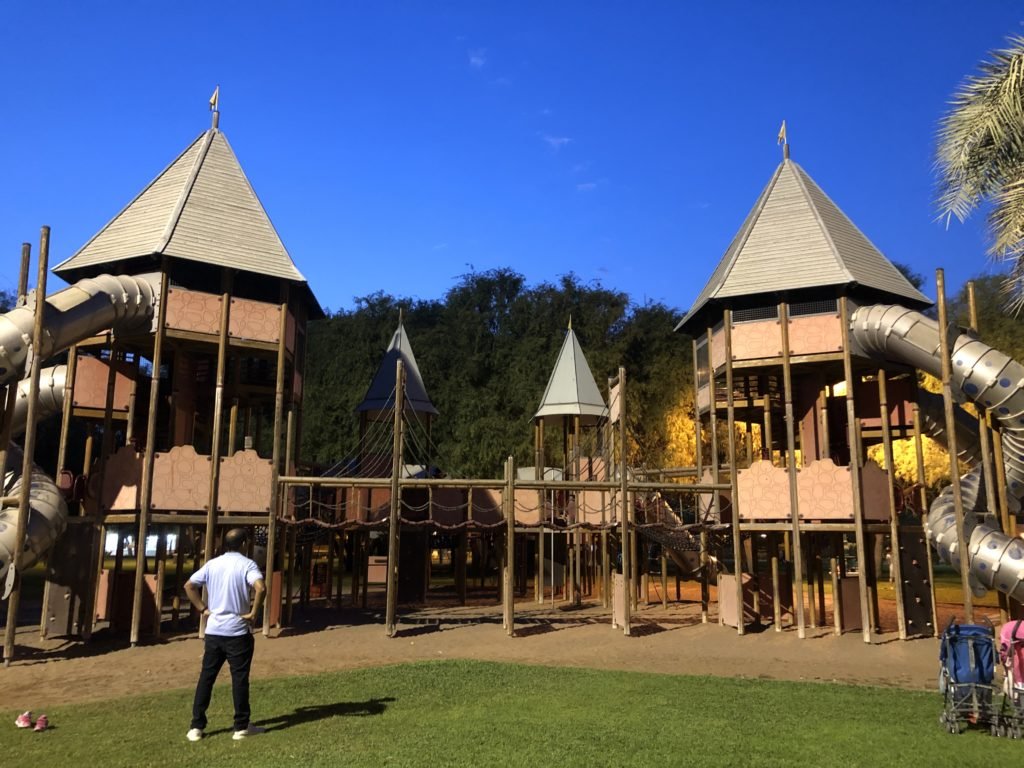
The playground structures were practically palaces!

Pop quiz 2…what is different about this Cosmopolitan magazine than you’d find elsewhere?

Oman may be a world away, but it never felt so far from home. That is, until we got in the nature…

